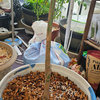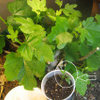Need advice on soil amendment for citrus tree
blazeaglory
12 years ago
Featured Answer
Sort by:Oldest
Comments (9)
hoosierquilt USDA 10A Sunset 23 Vista CA
12 years agolast modified: 9 years agoblazeaglory
12 years agolast modified: 9 years agoRelated Professionals
Londonderry Landscape Architects & Landscape Designers · Aurora Landscape Contractors · Concord Landscape Contractors · Cincinnati Landscape Contractors · Fort Worth Landscape Contractors · Fuquay-Varina Landscape Contractors · Haverhill Landscape Contractors · Kahului Landscape Contractors · Panama City Beach Landscape Contractors · Shaker Heights Landscape Contractors · Southbury Landscape Contractors · Tinton Falls Landscape Contractors · Yukon Landscape Contractors · Silver Firs Landscape Contractors · Acushnet Stone, Pavers & Concretehoosierquilt USDA 10A Sunset 23 Vista CA
12 years agolast modified: 9 years agoblazeaglory
12 years agolast modified: 9 years agorhizo_1 (North AL) zone 7
12 years agolast modified: 9 years agoblazeaglory
12 years agolast modified: 9 years agohoosierquilt USDA 10A Sunset 23 Vista CA
12 years agolast modified: 9 years agoblazeaglory
12 years agolast modified: 9 years ago
Related Stories

GARDENING GUIDESHow to Keep Your Citrus Trees Well Fed and Healthy
Ripe for some citrus fertilizer know-how? This mini guide will help your lemon, orange and grapefruit trees flourish
Full Story
GARDENING GUIDESSpring Citrus Care Reaps Months of Sweet Rewards
Learn how to tend citrus trees in spring and ways to preserve their delicious fruit
Full Story
GARDENING GUIDESHow to Stop Worrying and Start Loving Clay Soil
Clay has many more benefits than you might imagine
Full Story
GARDENING GUIDESHow to Pick a Mulch — and Why Your Soil Wants It
There's more to topdressing than shredded wood. Learn about mulch types, costs and design considerations here
Full Story
GARDENING AND LANDSCAPINGCitrus 101: Start Your Own Backyard Orchard
This Earth Day Weekend, Add Some Green, Style and Deliciousness to Your Landscape
Full Story
FARM YOUR YARDAdvice on Canyon Farming From L.A.'s Vegetable Whisperer
See how a screened garden house and raised beds help an edible garden in a Los Angeles canyon thrive
Full Story
GARDENING GUIDESGarden Myths to Debunk as You Dig This Fall and Rest Over Winter
Termites hate wood mulch, don’t amend soil for trees, avoid gravel in planters — and more nuggets of garden wisdom
Full Story
EDIBLE GARDENSHow to Grow 10 Favorite Fruit Trees at Home
Plant a mini orchard in fall, winter or early spring to enjoy fresh-off-the-tree fruit the following year
Full Story
LANDSCAPE DESIGNPretty Trees for Patios, Paths and Other Tight Spots
Choose trees for their size, shape and rate of growth — or shape them to fit your space. Here's how to get started
Full Story
GARDENING GUIDESWhen and How to Plant a Tree, and Why You Should
Trees add beauty while benefiting the environment. Learn the right way to plant one
Full StorySponsored
Central Ohio's Trusted Home Remodeler Specializing in Kitchens & Baths
More Discussions








johnmerr